Maximizing Search Engine Optimization with Secondary Dimension in Google Analytics
Maximizing Search Engine Optimization with Secondary Dimension in Google Analytics
Blog Article
Enhance Your Data Analysis Utilizing Additional Measurement in Google Analytics
Exploring the abilities of second dimensions in Google Analytics opens a world of opportunities for refining information evaluation. By layering extra measurements onto key information sets, a more intricate narrative arises, dropping light on individual interactions and efficiency indications.
Understanding Second Measurements
Additional dimensions in Google Analytics refer to added parameters that can be included to the key dimension, enabling for a more in-depth analysis of data (Secondary Dimension in Google Analytics). By integrating secondary measurements, analysts can segment and filter data to discover patterns, patterns, and connections that might not be apparent when looking at the data as a whole.

Advantages of Using Additional Dimensions
When analyzing data in Google Analytics, the use of additional dimensions offers important insights right into individual behavior and efficiency metrics. By adding an additional dimension to your key data, you can dig much deeper right into the attributes of your site visitors and their communications. One of the key advantages of using secondary measurements is the ability to section and contrast data extra effectively. This division enables you to understand just how different variables, such as demographics or web traffic sources, impact individual actions and conversions (Secondary Dimension in Google Analytics).
Additionally, secondary dimensions enhance the context of your key information, giving an extra thorough sight of user involvement and performance metrics. In general, the use of secondary dimensions in Google Analytics can dramatically improve the deepness and top quality of your information evaluation, leading to even more informed decision-making and improved end results.
Just How to Include Additional Dimensions
By including secondary dimensions in Google Analytics, customers can obtain deeper insights into their information evaluation process, allowing for even more thorough analysis of individual behavior and efficiency metrics. Including secondary measurements is a simple procedure that can dramatically improve the deepness of evaluation. To add a second dimension in Google Analytics, start by navigating to the record you wish to evaluate. When in the report, situate the "Additional dimension" tab over the information table. Click on it to disclose a dropdown menu with different alternatives such as Habits, Technology, and Personalized Dimensions. Select the measurement you wish to include, such as 'Source/Medium' or 'Gadget Group'. This second dimension will certainly after that be put on your existing data, giving additional context and enabling an extra comprehensive evaluation of user communications. By using second dimensions effectively, customers can discover valuable insights that may have or else been forgotten, resulting in educated decision-making and boosted efficiency approaches.
Analyzing Data With Second Dimensions
Using secondary dimensions in data evaluation provides a more extensive understanding of customer habits and efficiency metrics. By including an additional dimension to your main data set in Google Analytics, you can dig deeper right into the attributes of your web site visitors and their communications. Incorporating the primary dimension of 'source/medium' with the secondary measurement of 'touchdown web page' can disclose which certain pages are attracting website traffic from various resources, assisting you optimize these web pages for better engagement.

In essence, evaluating information with second dimensions empowers you to obtain useful insights right into customer habits, identify patterns, and make notified decisions to enhance the efficiency of your electronic properties.
Best Practices for Secondary Measurements
In data analysis, including additional measurements efficiently can considerably enhance the deepness of understandings stemmed from metrics and user behavior patterns. When utilizing this article second dimensions in Google Analytics or any kind of various other analytical device, it is critical to comply with best techniques to ensure the accuracy and significance of the data analysis.
One secret ideal practice is to meticulously choose secondary dimensions that match the primary measurement being examined. Selecting secondary dimensions that supply additional context or additional division can use a more thorough understanding of the information. It is also vital to stay clear of overcomplicating the analysis by including way too many additional dimensions, which may cause complication or dilution of understandings.
Furthermore, it is a good idea to trying out various mixes of key and secondary dimensions to discover brand-new connections and patterns. Regularly reviewing and fine-tuning the choice of secondary measurements based on the specific goals of the evaluation can lead to more actionable understandings. By complying with these ideal techniques, information experts can take advantage of second dimensions efficiently to enhance the overall data evaluation procedure and decision-making capacities.

Conclusion
To conclude, including second dimensions in Google find out this here Analytics is vital for a detailed information analysis technique. By leveraging additional measurements along with main ones, online marketers and experts can uncover useful insights and connections that can educate decision-making and optimize digital advertising and marketing strategies. Understanding just how to efficiently make use of second measurements and complying with finest methods will allow experts to remove meaningful information and improve their total efficiency metrics.
Second dimensions in Google Analytics refer to extra specifications that can be included to the primary dimension, allowing for a more detailed analysis of information. By incorporating additional dimensions, analysts can sector and filter data to discover patterns, fads, and connections that could not be apparent when looking at the information as a whole. Incorporating the key dimension of 'source/medium' with the secondary measurement of 'touchdown web page' can disclose which particular read review pages are bring in web traffic from various sources, aiding you maximize these pages for better involvement.
One key finest method is to thoroughly pick additional measurements that complement the primary measurement being analyzed. By complying with these best techniques, data analysts can take advantage of secondary dimensions successfully to improve the total data analysis procedure and decision-making capabilities.
Report this page